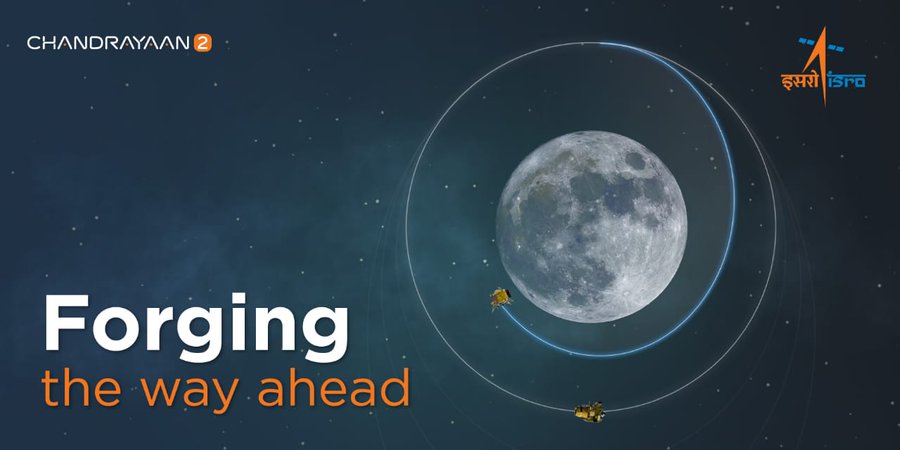India’s Chandrayaan-2 mission ready for historic landing on the Moon
 Chandraayan 2 was launched on July 22 in India.
Chandraayan 2 was launched on July 22 in India.
Later this week, India will attempt to become the fourth nation to successfully land on the Moon.
Now in its final stage, the Chandrayaan-2 mission is preparing for what has been dubbed “15 minutes of terror”.
That’s how long the final descent and landing will take on September 7, when the Indian Space Research Organisation (ISRO) attempts to drop a lander the size of a golf cart near the Moon’s south pole.
Late this afternoon, ISRO confirmed the lander had successfully detached from the orbiting spacecraft.
“All the systems of Chandrayaan-2 orbiter and lander are healthy,” ISRO reported.
If the high-stakes mission succeeds, India will join the Moon landing ranks of Russia, the US and China.
The arrival of new nations to space exploration takes us into a new era, said astronomer Jonti Horner of the University of Southern Queensland.
“It’s nice and refreshing to see that India and China are doing such great work in space because astronomy and space exploration is a global endeavour,” Dr Horner said.
But it will be extremely challenging.
“We take [landing on the Moon] for granted because the US and Russians got very good at it,” he said.
“It took a long time for them to get it right, and even then there were failures.
Chandrayaan’s journey to the Moon
Chandrayaan-2 (Sanskrit for “moon vehicle”) is India’s second lunar mission, but the first to attempt a soft landing on the Moon.
In planning for more than a decade, it was originally meant to be a joint venture with Russia, but the Russians pulled out following the failure of a mission to the Martian moon Phobos.
Since then, ISRO has gone it alone, building all the equipment with the exception of a last-minute addition from NASA.
“Chandrayaan-2 is proof India can do this, it’s actually proving their technology works, which is a big deal,” Dr Horner said.
There are three parts to the mission: the orbiting spacecraft; the Vikram lander named in honour of Dr Vikram Sarabhai who founded the Indian space program; and a rover called Pragyan, which is Sanskrit for “wisdom”.
The orbiting spacecraft, which is about the size of a bus, will sit at a distance of 100 kilometres from the Moon’s surface. It is equipped with eight scientific instruments including a high-resolution camera to map the Moon in 3D and find a good landing place.
The lander is carrying three sensors to probe the composition and movement of the Moon’s surface on the lookout for minerals and signs of moonquakes.
It’s also carrying a tiny reflector built by NASA. Like the experiments left on the Moon by the Apollo missions, this sensor will allow scientists to use lasers to accurately measure the distance from the Moon to orbiting spacecraft.
The little six-wheeled rover, which weighs only 27 kilograms, also has two instruments designed to identify the chemical composition of the surface up to 500 metres away from the lander.
Where’s it going to land?
The mission is set to explore a region near the south pole — the top of the Moon as seen from Australia.
Vikram will land somewhere between two craters — Manzinus C and Simpelius N — located between 67 and 73 degrees south on the side of the Moon facing us.
While that’s in the highlands outside the polar circle, and about 600 km from the pole itself, it is the furthest south any spacecraft has attempted to land.
The south pole is interesting for a number of reasons, Dr Horner said.
Firstly, it is the site of the largest, deepest and oldest feature on the Moon’s surface: the South Pole-Aitken basin.
This 2,500 km wide scar was created when an asteroid slammed into the Moon around 3.9 billion years ago.
The impact exposed material from deep within the Moon at a time when it was still young and molten.
Rocks flung out to the proposed landing site about 350km away from the basin’s most northerly edge could provide a glimpse of what this part of the Moon was like before it became a frozen, solid mass.
“It tells us a lot about the formation of the Moon,” Dr Horner said.
“Otherwise, we’re just looking at the surface of the Moon and just inferring what the interior is like.”
These rocks could also contain new minerals and helium-3, which is a potential source of energy.
Even more importantly for future missions, the south pole is known to have water above and below the surface.
Instruments on board India’s first mission, Chandrayaan-1, identified water ice in permanently shaded craters on the Moon’s south and north poles.
Since then, the south pole — even though the temperature in the permanently shaded areas is colder than any of the planets in the solar system — has been eyed up as a potential site for a moon base by the US and other nations.
“That water is going to be invaluable,” Dr Horner said.
“It means you don’t have to take water with you obviously, but it’s also a source of hydrogen for fuel.”
So how do you land on the Moon?
Unlike the Apollo missions, which took about three days to touchdown, Chandrayaan-2 has taken six weeks to go into orbit around the Moon.
“They’re doing everything very slowly, very gently, in a very efficient fashion. That’s why it’s taking a while,” Dr Horner said.
The orbiting spacecraft is now sitting around 100km from the surface, where it will stay for the next year.
Over the next five days, the Vikram lander will inch towards the surface using thrusters to slow it down to the same speed as the Moon’s surface.
“It’s very different to landing something on the Earth where you’ve got atmosphere and things like that to help you slow down,” Dr Horner said.
“It’s what they call a powered descent.
“You’ve got to slow down from the speed you’re moving in orbit, which is still a couple of kilometres per second relative to the surface, down to essentially zero.”
Once it’s at the right location and travelling at the right speed it will fire its rockets to attempt the soft landing.













